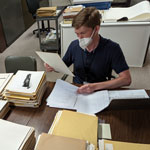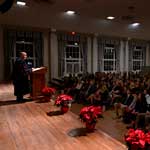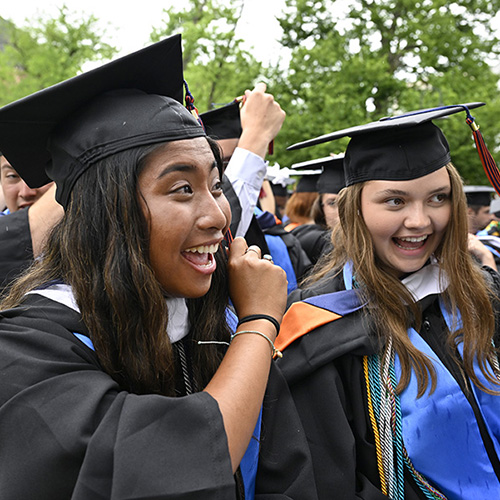
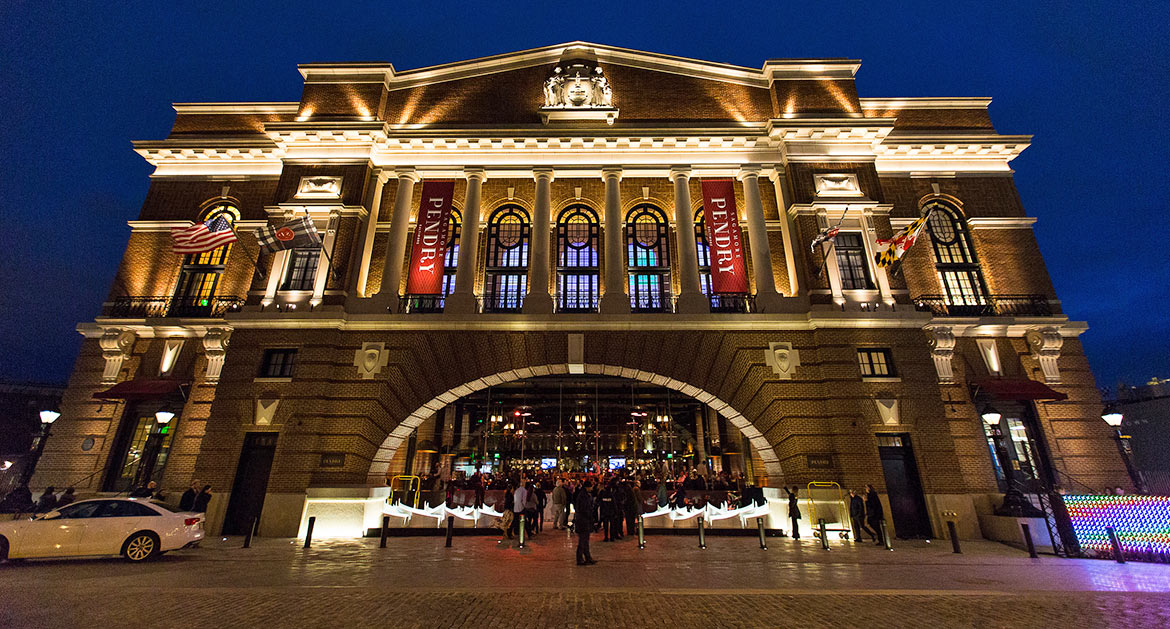
It’s a frigid morning in mid-December just off Baltimore’s Inner Harbor, the temperature barely north of 20 degrees. But as he prepares to conduct a tour of the still-under-construction Sagamore Pendry hotel, on the waterfront in the city’s Fells Point neighborhood, Alan Fuerstman ’78 seems oblivious to the elements. Fuerstman is the founder, chairman, and CEO of Montage International, the California-based ultra-luxury hotel and resort management company that he founded 15 years ago and that he’s led with the same laser vision he’s exhibiting now—as he steps off Thames Street, passes beneath the hotel’s massive arched entrance, and wades into a small army of construction workers in hard hats. Weather? What weather?
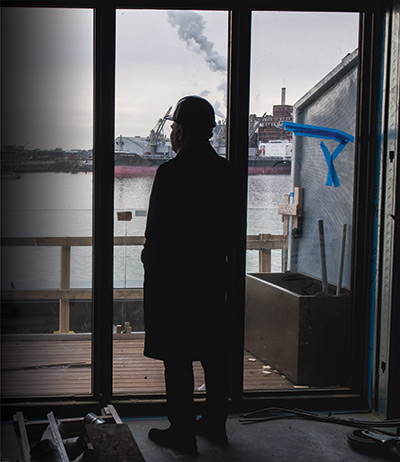 For Fuerstman, the Sagamore Pendry represents a departure from the business model that has produced five wildly successful Montage properties—in California (Laguna Beach and Beverly Hills), Utah, South Carolina, and Hawaii. In 2014, in collaboration with his son Michael, Fuerstman set out to create a new brand of hotels in markets that still demanded top-shelf amenities and service but could not support a Montage property’s nightly room fee, which starts around $600. “That may not be a 600-square-foot room; it may be a 350- or 400-square-foot room,” Fuerstman said earlier this morning, over breakfast at the nearby Four Seasons, by way of explaining the Pendry difference. “It may not be a five-fixture bath; it may be a three-fixture bath.”
For Fuerstman, the Sagamore Pendry represents a departure from the business model that has produced five wildly successful Montage properties—in California (Laguna Beach and Beverly Hills), Utah, South Carolina, and Hawaii. In 2014, in collaboration with his son Michael, Fuerstman set out to create a new brand of hotels in markets that still demanded top-shelf amenities and service but could not support a Montage property’s nightly room fee, which starts around $600. “That may not be a 600-square-foot room; it may be a 350- or 400-square-foot room,” Fuerstman said earlier this morning, over breakfast at the nearby Four Seasons, by way of explaining the Pendry difference. “It may not be a five-fixture bath; it may be a three-fixture bath.”
Still, let’s be clear: No one will ever mistake the Sagamore Pendry for a Motel 6. The new hotel, a $60 million project, features a steakhouse restaurant, a whiskey bar, a 4,500-square-foot ballroom, two 550-square-foot conference rooms, and a second-floor outdoor pool with views of the Inner Harbor and the Baltimore skyline. The typical room comes with a private balcony, a king-sized bed, millwork paneled walls, and marble accents. Nightly rates start at $359, before taxes.
Leading the tour of the hotel, sidestepping wheelbarrows, portable heaters, panels of plywood and sheetrock, a thousand or so electrical wires snaking along the floors, and a beehive of laborers, Fuerstman can hardly contain his excitement. At one point, after reciting a litany of the hotel features—historical, geographical, architectural, and otherwise—he said, “This hotel is destined to be one of America’s finest.”
Fuerstman knows a thing or two about America’s finest hotels. He’s staked his long and fruitful career on providing wealthy travelers with lavish accommodations, impeccable service, and a white-glove attention to detail. Surely he endeavors to repeat that success with the Pendry brand, and his track record gives him plenty of reason for optimism. With the 2003 opening of the 250-room Montage Laguna Beach—30 acres of palm-treed paradise overlooking the Pacific Ocean—Fuerstman sought to redefine ultra-luxury hospitality. He wanted to break away from what he calls the “old-school style” of luxury, which he saw as too pretentious. “I thought the next generation of luxury travelers were looking for a more gracious, humble approach to it,” Fuerstman said, “where you could be as comfortable in a luxury hotel or resort in jeans as you are in a tuxedo. Where you could still appreciate the craftsmanship, the attention to detail. But it didn’t need to be surrounded in the traditional trappings of luxury.”
To his delight, Fuerstman was right about that next generation, and he was pleasantly surprised to learn that the old-school crowd likewise embraced the Montage approach. His colleagues and competitors have taken note. While developing Montage into one of the leading ultra-luxury hotel brands, Fuerstman has received some of the industry’s highest honors, including the 2014 Robert Mondavi Wine and Food Award, presented by the Collins College of Hospitality Management at Cal Poly Pomona (previous winners, besides its namesake, include the culture-bending chefs Julia Child and Alice Waters). Today, Montage employs about 3,400 people and manages more than $1 billion in residential real estate, and this year the company expects to generate revenues in excess of $400 million.
Fuerstman enrolled at Gettysburg as a political science major, figuring one day he’d go on to law school. He got his start in hospitality while still in high school in New Jersey, working as a doorman at the Saddle Brook Marriott, a job he returned to each summer while attending Gettysburg. Even from his lowly station at the hotel, Fuerstman fell hard for the business. Law school would have to wait. “I loved the energy, the excitement, the complex business strategy, the tactics, the competitiveness of the industry,” he said.
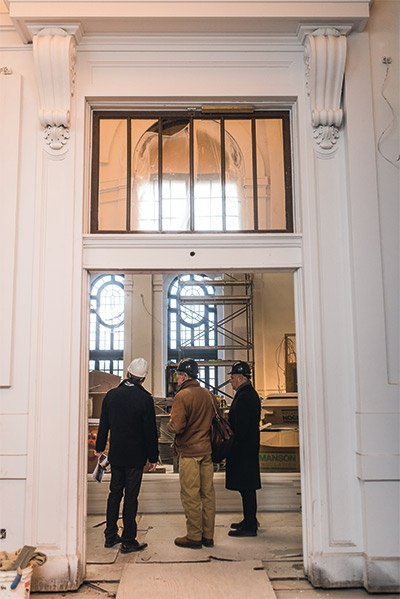 After graduating, Fuerstman took a job as a bell captain at the Rancho Las Palmas Resort in California, a Marriott International property with five restaurants and a 27-hole golf course. He was on his way, changing jobs every few years and gaining valuable experience at each stop. He helped open multiple hotels for Marriott, including the company’s signature property, the Desert Springs, in Palm Desert, California. At the El Conquistador Resort and Country Club in Tucson, then an ITT Sheraton property, he took his first job as general manager. In 1994, he was named president and managing director at The Phoenician, in Scottsdale, Arizona, then ITT Sheraton’s flagship luxury hotel. And four years later he was tapped by Steve Wynn, the casino mogul, to help open Wynn’s newest property, the 3,000- room Bellagio on the Las Vegas Strip.
After graduating, Fuerstman took a job as a bell captain at the Rancho Las Palmas Resort in California, a Marriott International property with five restaurants and a 27-hole golf course. He was on his way, changing jobs every few years and gaining valuable experience at each stop. He helped open multiple hotels for Marriott, including the company’s signature property, the Desert Springs, in Palm Desert, California. At the El Conquistador Resort and Country Club in Tucson, then an ITT Sheraton property, he took his first job as general manager. In 1994, he was named president and managing director at The Phoenician, in Scottsdale, Arizona, then ITT Sheraton’s flagship luxury hotel. And four years later he was tapped by Steve Wynn, the casino mogul, to help open Wynn’s newest property, the 3,000- room Bellagio on the Las Vegas Strip.
By 2000, Fuerstman had achieved a heady ascent in a demanding industry, but he was just getting started. He’d always had an entrepreneurial spirit, and he began to entertain notions of his own hotel company based on his outside-the-box ideas about luxury travel. He partnered with Pierre Omidyar, the founder of eBay, who became an investor in Fuerstman’s fledgling company. Then, he found a property under construction—initially intended to be a Ritz-Carlton—on the oceanfront in Laguna Beach. “When I stepped on the property in Laguna,” Fuerstman recalled, “I fell in love with it and knew that it would be the ideal platform.” He arranged to buy the property in a deal worth about $200 million.
Now, all he needed was a name for his company.
Those who work closely with Fuerstman marvel at his ability to excel in so many aspects of hotel management, even down to architectural design. At Laguna Beach, as he would with all subsequent properties, Fuerstman wanted to incorporate design elements that reflected the surroundings. The cookie-cutter approach would not suffice. “I was searching for a more authentic experience,” Fuerstman said. “A sense of place, a spirit of place.”
Laguna Beach is a well-to-do arts community, midway between Los Angeles and San Diego, whose architecture is strongly influenced by the Craftsman style popularized in the early 20th century. When Fuerstman first toured the future hotel site, the architectural plans had been drawn and construction had begun. But in the hotel’s fifth-floor main lobby, with its panoramic view of the Pacific, he saw an opportunity to fulfill his aesthetic vision. The lobby had been designed to be enclosed by a solid glass wall. Fuerstman wanted to take full advantage of the stunning vista, so he had installed large sliding glass doors instead—as he said, “to bring the outside in and the inside out.”
“It changed the feel and experience the moment you walk in there,” said James Bermingham, the executive vice president of operations for Montage International. “It’s a small example of the eye that he has. I don’t think I would have seen that until after we opened.”
Fuerstman has known Bermingham since his days at The Phoenician, and when he started Montage he placed one of his first phone calls to Bermingham, who was then managing two hotels in Washington, D.C. Bermingham toured the property in Laguna Beach and came away duly impressed. He called his wife, Priscilla, told her he was inclined to accept Fuerstman’s offer, and said she should fly out to see the property. “She said, ‘If it’s Alan Fuerstman, and you really like it, I don’t need to come out,’” Bermingham recalled. “For a mother of young kids to say, ‘We’ll go, sight unseen, because it’s Alan Fuerstman,’ that really says it all.”
Fuerstman was getting ready to announce the acquisition of the Laguna Beach property. But he still hadn’t decided on a name for his company. He went to his advertising agency, which suggested hundreds of names. He rejected every one. He went to his public relations company and offered a $10,000 reward for anyone who came up with a winning name. He rejected every one of them as well. Time was running out.
Drawing on Laguna Beach’s history as an artists’ colony, Fuerstman consulted an online art reference guide. When he got to the M’s, he came across the term montage. It said something about an “artful collection.” Fuerstman thought the name reflected perfectly the vision he had for his business. “I wanted to create a collection of individuals coming together doing extraordinary things,” he said.
So, what makes a Montage property? “Style of service, the warmth, the approachability of our staff, the incredible execution of service, the physical attributes of the property, the amenities, the food and beverage, the spa experience,” Fuerstman said. “Ultimately, it all comes together to create an experience where, if you stay at a Montage hotel or resort, you’re made to feel different. And it’s more experiential than marketing hype.”
Success came quickly. In 2008, just five years after the opening of Montage Laguna Beach, industry leaders chose Fuerstman as the Resort Executive of the Year. Five years later he received an Ernst & Young Entrepreneur of the Year Award. The following year came the Mondavi Award. Along the way, he’s been featured in The New York Times and The Wall Street Journal, and Travel & Leisure has listed Montage properties in South Carolina, Hawaii, and Beverly Hills, among the top 100 hotels in the world. Montage residences routinely carry multimillion-dollar price tags (a Montage Beverly Hills residence recently sold for $23 million). Today, Fuerstman and his wife, Susan, a lawyer, live at Montage Laguna Beach.
For Fuerstman, part of the joy of creating Montage has been bringing his four children into the business. His younger son, Drew, a musician, performs at the hotels. His older daughter, Heather, was spa manager in Laguna Beach for five years. His other two children are full-time employees (and both had their weddings at Montage Laguna Beach). Jessica Fuerstman-Byrne is the communications manager for Montage International. Michael Fuerstman, 33, the cofounder and creative director of Pendry Hotels, speaks by phone with his father multiple times a day. “He’s a very average person, and I mean this in the most flattering way,” Michael says. “What he’s done is exceptional. But he is very much a simple, everyday kind of guy. I think it’s served him really well. He listens to his instincts. That mindset allows him to relate to both our guests and our associates in a way that a corporate executive persona typically does not.”
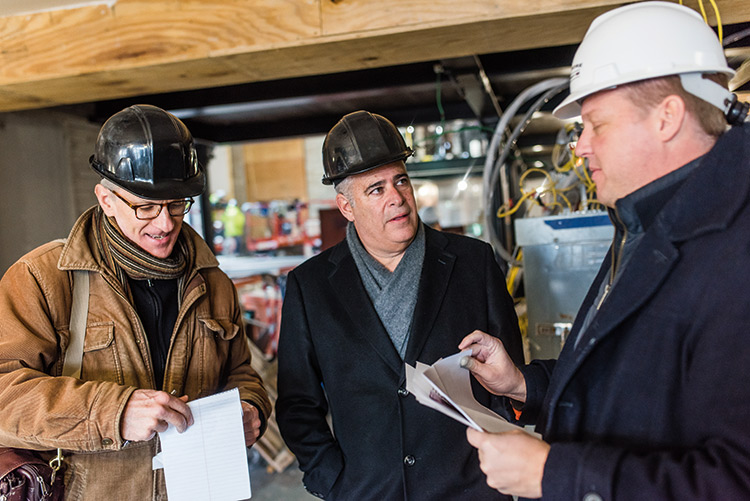
For Alan Fuerstman, the location of the Sagamore Pendry Baltimore was a key attraction. The hotel, which opened in March, consumes an imposing, four story brick building atop Recreation Pier—Rec Pier, the locals call it—a long-neglected but historically significant site. Built in 1914, Rec Pier served as the landing point for thousands of newly arrived immigrants processed just across the Patapsco River at the Locust Point immigration station. But the building had been vacant for years when Kevin Plank, founder and CEO of Under Armour, the sportswear behemoth, bought it in 2014 for $3.4 million (Under Armour’s headquarters sit directly across the river from the Sagamore Pendry; Plank goes back and forth in a local water taxi). When Plank moved forward with his hotel plans, he asked Pendry to manage the property.
Alan Fuerstman considered Rec Pier the perfect locale, in the perfect neighborhood, for the second Pendry hotel (the first, in downtown San Diego, opened in February). Fells Point, whose cobblestone streets house Maryland’s first National Historic District, is known mostly for its concentration of bars, restaurants, and nightclubs, and for its funky bohemian edge. “Fells Point is a gem of a location,” Fuerstman said. “It speaks to the emerging vibrancy that we’re looking for.”
On April 1, the hotel’s ballroom was the site of a reception and dinner on behalf of Gettysburg Great: The Campaign for Our College, an event that Fuerstman, a longtime donor and a Trustee since 2006, helped make possible. President Janet Morgan Riggs ’77 was among the College leaders who made the 60-mile trip to Baltimore to meet with local alumni and donors and promote the campaign.
Since the mid-1990s, Fuerstman has provided the College with event space, free of charge, at Montage and other properties. He’s also provided Montage internships for Gettysburg students with free event space at Montage and other properties.
Robert Kallin P’12, the vice president of development, alumni and parent relations, credits Fuerstman with bringing together Gettysburg alumni, parents, and donors from across the country. “Alan has been very generous by providing an extremely attractive venue around which we can build momentum in support of the College,” Kallin said. “It’s enabling others to stay engaged, and I think that’s an important contribution.”
Surrounded on three sides by water—it’s a pier, after all—Rec Pier enabled Fuerstman to fulfill his vow to design each of his properties with a strong sense of place. Thus, the look of the Sagamore Pendry Baltimore was driven by a nautical theme, its 128 rooms designed to resemble ship’s quarters, with half of them offering water views. During construction, work crews dredged from the river bottom three 19thcentury cannons. One of them will be displayed beneath a glass floor in the whiskey bar, known as the Cannon Room. The ballroom, restored to its former grandeur, will accommodate weddings and other events for up to 300 people. Guests will approach the ballroom from a grand marble staircase sheathed in red carpet. “It’s going to be the best ballroom in Baltimore,” Fuerstman said.
It’s not a boast as much as a vision, the sort of vision that has propelled Fuerstman through a career in luxury hospitality now approaching four decades. Whether from Baltimore’s Inner Harbor or California’s Laguna Beach or Hawaii’s Kapalua Bay, it seems Fuerstman is forever peering at some distant horizon. Later this year, Pendry will begin construction of its third property, in West Hollywood, California. And next year, in Cabo San Lucas, at the southern tip of Mexico’s Baja California peninsula, Montage International will open its first hotel outside the United States.

